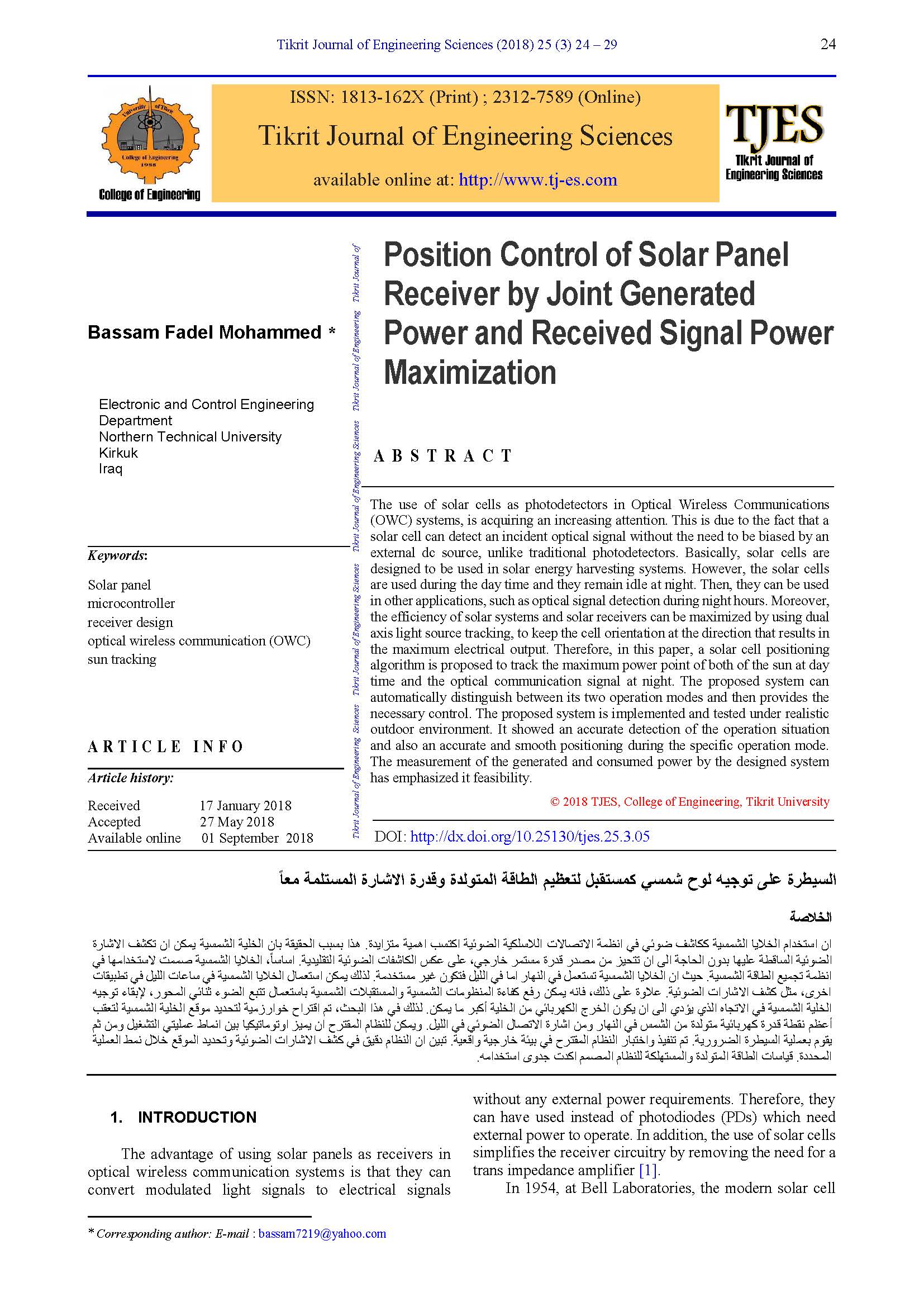Position Control of Solar Panel Receiver by Joint Generated Power and Received Signal Power Maximization
Main Article Content
Abstract
The use of solar cells as photodetectors in Optical Wireless Communications (OWC) systems, is acquiring an increasing attention. This is due to the fact that a solar cell can detect an incident optical signal without the need to be biased by an external dc source, unlike traditional photodetectors. Basically, solar cells are designed to be used in solar energy harvesting systems. However, the solar cells are used during the day time and they remain idle at night. Then, they can be used in other applications, such as optical signal detection during night hours. Moreover, the efficiency of solar systems and solar receivers can be maximized by using dual axis light source tracking, to keep the cell orientation at the direction that results in the maximum electrical output. Therefore, in this paper, a solar cell positioning algorithm is proposed to track the maximum power point of both of the sun at day time and the optical communication signal at night. The proposed system can automatically distinguish between its two operation modes and then provides the necessary control. The proposed system is implemented and tested under realistic outdoor environment. It showed an accurate detection of the operation situation and also an accurate and smooth positioning during the specific operation mode. The measurement of the generated and consumed power by the designed system has emphasized it feasibility.
Metrics
Article Details

This work is licensed under a Creative Commons Attribution 4.0 International License.
THIS IS AN OPEN ACCESS ARTICLE UNDER THE CC BY LICENSE http://creativecommons.org/licenses/by/4.0/
Plaudit
References
Wang Z, Tsonev D. On the design of a solar-panel receiver for optical wireless communications with simultaneous energy harvesting. IEEE 2015; 33 (8): 1612-1623. [2] Dutta A. Prospects of nanotechnology for high-efficiency solar cells. 7th ICECE: pp. 347-350; 2012. [3] Reddy PJ. Science & Technology of Photovoltaics. 2nd ed. Leideu, The Netherlands: CRC Press, 2010. [4] Manna TK, Mahajan S. Nanotechnology in the development of photovoltaic cells. ICCEP: pp. 379-386; 2007. [5] Green MA. Third generation photovoltaics: Ultra-high conversion efficiency at low cost. Progress in Photovoltaics: Research and Applications 2001; 9 (2): 123-135. [6] Razykov T, et al. Solar photovoltaic electricity: current status and future prospects. Solar Energy 2011; 85 (8): 1580-1608. [7] King RR et al. Solar cell generations over 40% efficiency. Progress in Photovoltaics: Research and Applications 2012; 20 (6): 801-815. [8] Green MA, Emery K, Hishikawa Y, Warta W. Solar cell efficiency tables (version 37). Progress in Photovoltaics: Research and Applications 2011; 19 (1): 84-92. [9] Mims F. Light-comm. Element Electron 1972: 29-95. [10] Elgala H, Mesleh R, Haas H. Indoor optical wireless communication: Potential and state-of-the-art. IEEE Communications Magazine 2011; 49 (9): 56-62. [11] Öztürk A, Alkan S, Hasirci U, Tosun S. Experimental performance comparison of a 2-axis sun tracking system with fixed system under the climatic conditions of Düzce, Turkey. Turkish Journal of Electrical Engineering and Computer Sciences 2016; 24 (5): 4383-4390. [12] Gabe IJ, Bühler A, Chesini D, Frosi F. Design and Implementation of a Low-Cost Dual-Axis Autonomous Solar Tracker. PEDG, IEEE 8th International Symposium, 2017. [13] Kim SM, Won JS. Simultaneous reception of visible light communication and optical energy using a solar cell receiver. ICTC, IEEE International Conference, 2013. [14] Chen HY, et al. Passive optical receiver for visible light communication (VLC). TENCON, IEEE Region 10 Conference, 2015. [15] Hsu CW, et al. Visible light positioning and lighting based on identity positioning and RF carrier allocation technique using a solar cell receiver. IEEE Photonics Journal 2016; 8 (4): [16] Malik B, Zhang X. Solar panel receiver system implementation for visible light communication, electronics, circuits, and systems (ICECS), IEEE International Conference, 2015. [17] Wang Z, Tsonev D, Videv S, Haas H. Towards self-powered solar panel receiver for optical wireless communication. Communications (ICC), IEEE International Conference: 2014.





